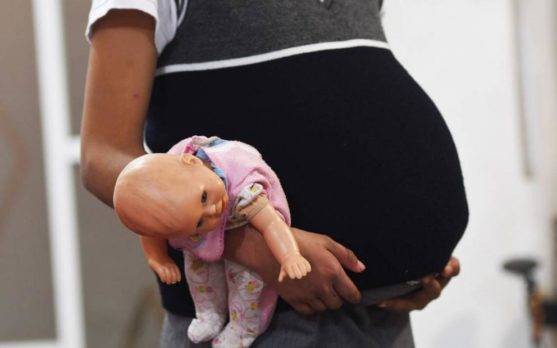For the International Day of the Girl, which is commemorated every year on October 11; To raise awareness about the plight of girls around the world, the United Nations Children’s Fund (UNICEF) highlights that the Dominican Republic faces significant challenges in terms of early motherhood and the high birth rate in adolescents.
According to the recent report of the National Survey of Multiple Purpose Households (ENHOGAR-MICS 2019), 20% of women between 15 and 19 years old have already had a child born alive or are pregnant with their first child, an alarming figure that reflects the need to strengthen sexual and reproductive health and education policies in the country.
The adolescent fertility rate in the country is 77 births per 1,000 women between 15 and 19 years old, placing it among the highest in Latin America.
Furthermore, ENHOGAR-MICS 2019 shows that 15% of Dominican women began their sexual life before the age of 15, which underlines the urgency of implementing effective prevention and support programs for these young women.
“In the context of the commemoration of Day of the Girl, it is imperative to highlight the unique challenges they face, especially in upper-middle-income countries like the Dominican Republic. In the world, there are more than 600 million adolescent girls between 10 and 19 years old, the largest number in history. If these girls are given the right resources, opportunities and an enabling environment, they can become the greatest generation of women leaders, entrepreneurs and change-makers the world has ever seen,” added UNICEF representative Carlos Carrera.
However, the reality is that women and girls continue to face significant disadvantages in various spheres such as health, education, political participation and economic opportunities.
One in four girls between 15 and 19 years old has suffered physical or sexual violence from their partner at least once in their life.
Teenage pregnancy is one of the leading causes of mortality among adolescent girls, and four out of ten adolescents aged 15 to 19 who wish to avoid pregnancy do not have access to contraception.
Worldwide, girls aged 5 to 14 spend 160 million more hours a day on unpaid domestic and care work than boys of the same age, a burden that intensifies during adolescence.
Furthermore, almost one in five girls does not finish the lower secondary cycle and almost four in ten do not complete the second cycle. Around 90% of adolescent girls and young women in low-income countries do not use the Internet, while their male peers are twice as likely to access the Internet.
International Day of the Girl, an opportunity for change: #GirlsWithGoals
“This anniversary represents a key moment to highlight the unique challenges that girls face, especially in developing countries, and to promote their empowerment and the fulfillment of their rights. It is essential to provide them with the right resources, opportunities and a safe environment so that they become the future leaders, entrepreneurs and agents of change that the world needs,” Carrera said.
The current generation of girls faces pressing challenges, such as the climate crisis, conflict and poverty, as well as setbacks in human rights and gender equality. Despite this, more than 80% of adolescent girls globally maintain hope for a better future.
The campaign conceived by UNICEF for this date has been called #NiñasConMetas or #GirlGoals, and it has some points as main focuses:
Financing: There is a significant lack of funding for initiatives that promote girls’ rights and well-being. Increasing investments in health, education and economic empowerment is essential to advance the Sustainable Development Goals (SDGs).
Girl-centered policies: Policies and programs must be designed based on the needs of girls themselves, listening to their voices and addressing barriers such as gender violence and discrimination in education.
Health and nutrition: Maternal mortality and HIV are serious problems for adolescent girls. Only 15% have access to the HPV vaccine. It is necessary to increase access to health and nutrition services.
Violence: Violence affects one in four adolescents. It is urgent to prevent gender violence and respond appropriately to survivors, considering the high economic costs it entails.
Education: Adolescent girls drop out of high school at high rates. Investments in quality education benefit girls and society as a whole, increasing their economic opportunities.
Job opportunities: Adolescent girls face greater barriers to accessing education and employment compared to boys. Investment is required in education and in eliminating gender pay gaps.

Impact and call to action
UNICEF emphasizes that the impact of teenage pregnancies and early unions not only affect the lives of these young women, but also the socioeconomic development of the country. It is essential to intensify efforts to provide comprehensive sexuality education, improve access to contraception and offer adequate and confidential health services.
“In the framework of the International Day of the Girl, from the United Nations Children’s Fund we call on authorities, organizations and society in general to redouble efforts to achieve gender equality, which is not only a human right, but an indispensable condition for sustainable development,” said the spokesperson for the international organization.
The highest authority of UNICEF in the country stated: “Urgent measures are needed to drive progress with and for girls. Actively investing in the future of girls is investing in our own future. Together we can build a present and a future in which the rights of all girls are protected. Because when girls achieve their goals, we will all get closer to achieving our Global Goals.”
Other insights into global figures
- Today, one in five young women between the ages of 20 and 24 was married as a child.
- One in eight girls and women have been raped or sexually abused before the age of 18, according to new UNICEF estimates released today.
- According to the data, the majority of cases of sexual violence in childhood occur during adolescence, with a significant spike between 14 and 17 years of age. Studies also show that boys and girls who suffer sexual violence are more likely to suffer repeated abuse. In this sense, the implementation of specific interventions during adolescence is crucial to break this cycle and mitigate the long-term consequences of these traumas.
- Worldwide, 75% of new HIV infections among adolescents occur in girls.
- Almost twice as many teenage girls (one in four) as boys do not receive any type of education, employment or training.


















